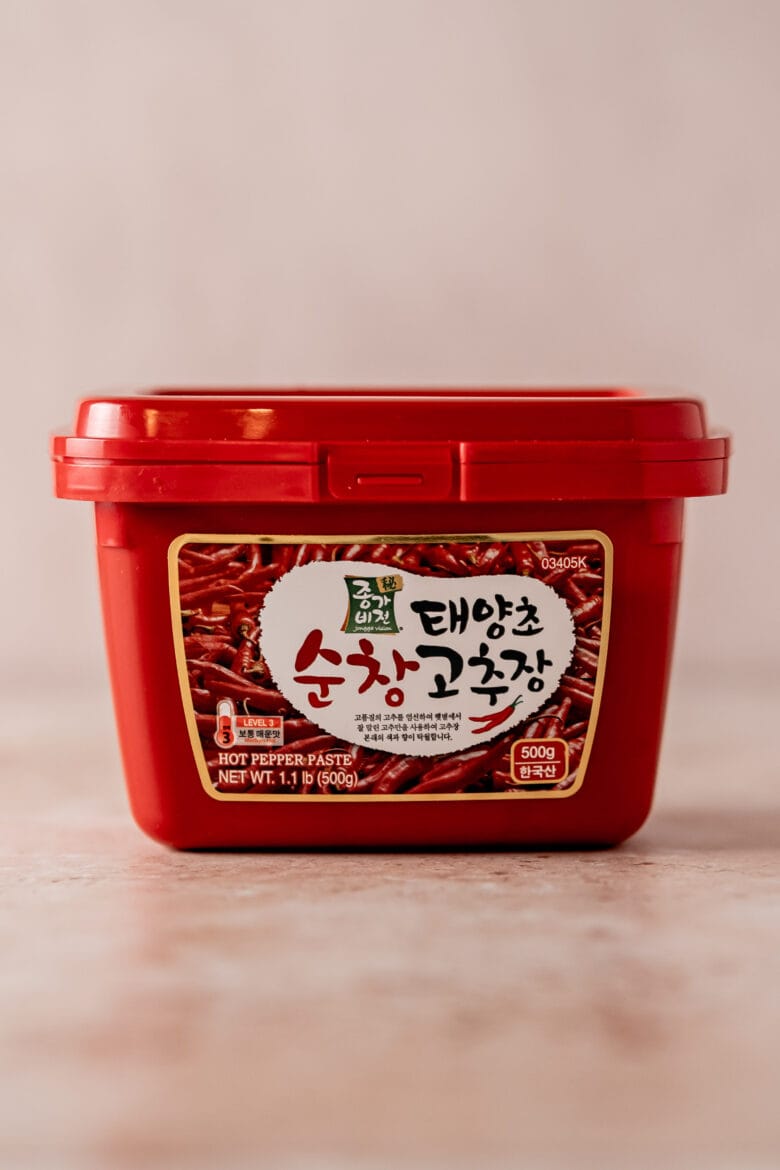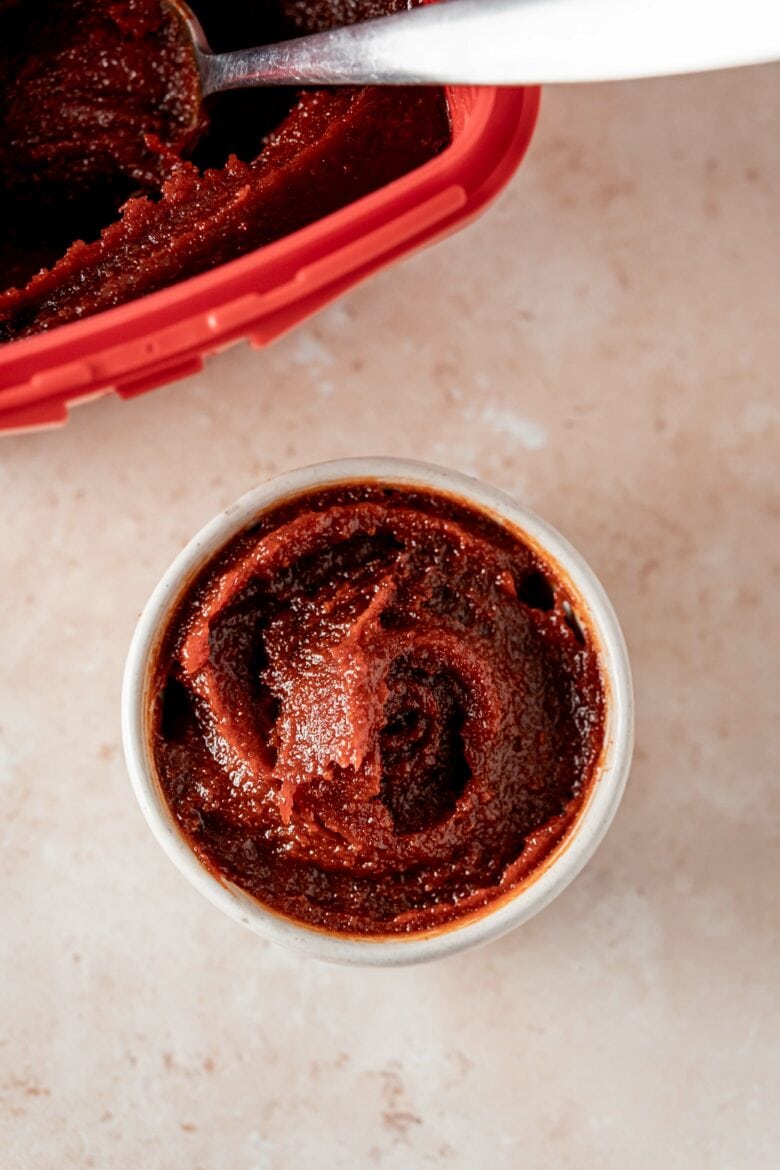Need a Gochujang substitute for dinner tonight? We’ve got you covered with these 10 alternatives that will add depth and heat to your dish!
What’s the best Gochujang substitute? It really depends on what you’re making. You’ll want to consider the flavor profile, desired heat level and additional ingredients in your recipe.
Just looking to add some heat to an already intricate dish? Maybe a dash of Sriracha will suffice. Or maybe you want to add depth to a hearty stew. Read on to see how we combine pantry ingredients to make the perfect Gochujang alternative!

What is Gochujang?
Gochujang is a fermented red pepper paste used in Korean cuisine. It’s made from red chili pepper flakes (gochugaru), glutinous rice, fermented soy beans (meju) and salt.
Gochujang is spicy, sweet, savory and a little… funky? And I mean that in the very best way possible! The fermentation process contributes to Gochujang’s distinctive flavor, adding an incredible amount of depth to soups, stews, marinades and sauces. It’s also the key ingredient in our Baked Gochujang Wings!

The best Gochujang substitutes
Before we get to the perfect Gochujang substitute, it’s important to note that the red pepper paste may not be as hard to find as you think. It’s readily available online and I’ve seen it at a variety of grocery stores across the Midwest in the US.
But if you just need a tablespoon or don’t have time to run to the store, we’re sure one of these Gochujang alternatives will be the perfect fit!
1. Sriracha
Sriracha is a pantry staple in many homes, which is why it’s first on our list. The Thai chili sauce is spicy, fresh and tangy, but lacks the umami flavor of Gochujang.
Sriracha is a great Gochujang substitute when you just want to add a bit of heat to a dish that already has complexity from other ingredients.
Substitution notes: Consider adding miso paste along with Sriracha to get the fermented and umami notes of Gochujang.
1 tablespoon gochujang = 1/2 tablespoon sriracha.
2. Hoisin Sauce
Hoisin sauce is made with fermented soybean paste and is often seasoned with sesame, garlic and chiles. While the flavor differs from Gochujang, Hoisin sauce tends to complement similar ingredients, making it a suitable alternative for marinades, glazes and dips.
Hoisin sauce has the sweet, salty and umami flavor profile of Gochujang, but lacks the heat. This makes it a great Gochujang substitute for those who are looking for a non-spicy alternative.
Psst: We’ve also got you covered if you need a Hoisin sauce substitute!
Substitution notes: Combine Hoisin sauce with a spicy element (such as Sriracha or red pepper flakes) for a sweet and spicy flavor.
1 tablespoon gochujang = 1 tablespoon hoisin sauce.
3. Miso Paste
Miso is a fermented soybean paste popular in Japanese cuisine. Because fermented soybeans are also a component of Gochujang, miso is a great substitute when you’re looking to get an umami-rich and savory flavor.
White miso (shiro miso) and red miso (aka miso) are the most commonly available varieties in the US. White miso is milder, while red miso has a pungent flavor due to a longer fermentation period.
Substitution notes: Miso paste provides a fermented umami flavor. To replicate the sweet and spicy notes of Gochujang, try adding honey or brown sugar along with cayenne pepper or red pepper flakes.
1 tablespoon gochujang = 1 tablespoon miso paste.
4. Chili Garlic Sauce
Chili garlic sauce provides a spicy kick but lacks the fermented sweetness and depth of Gochujang. It can be a good Gochujang substitute in stir-fries, marinades and dips.
Chili garlic sauce is also a popular Sambal Oelek substitute, and either condiment would work as a Gochujang alternative.
Substitution notes: Adjust the quantity based on your spice tolerance. Consider adding a touch of soy sauce or miso paste for depth.
1 tablespoon gochujang = 1 tablespoon chili garlic sauce.
5. Harissa
Harissa is a North African chili paste with a smoky flavor. It should only be used as a Gochujang substitute if you’re up for an adventure in your kitchen, as it will take your recipe in a completely different direction!
Harissa can be a flavorful addition to marinades for grilled meats and also works well in stews.
Substitution notes: Harissa is often seasoned with coriander, caraway and cumin. These ingredients aren’t common in Korean cooking, so may clash with your recipe. Proceed with caution!
1 tablespoon gochujang = 1 tablespoon harissa.
6. Gochugaru (Korean Red Pepper Flakes)
Gochugaru is actually an element of Gochujang, which makes it a great substitute. Gochugaru isn’t as spicy as many other chile powders and flakes, so you can add more flavor without overwhelming your dish with heat.
You can buy Gochugaru in powder form or coarse flake form. Gochugaru can be a good Gochujang substitute in dry rubs, soups and stews.
Substitution notes: Gochugaru is a coarse powder or flake and won’t replicate the consistency of Gochujang. Consider adding miso paste to create a Gochujang substitute that has a more similar texture and depth of flavor.
1 tablespoon gochujang = 2 teaspoons gochugaru.
7. Doenjang
Doenjang is a Korean fermented soybean paste and is often compared to Japanese miso. Doenjang is rich, savory and earthy with a deep umami flavor. While it’s a great Gochujang substitute, it’s lower on our list simply because it’s often harder to find than Gochujang.
Doenjang works well in soups, stews and marinades.
Substitution notes: Doenjang lacks the sweetness and spiciness of Gochujang. Add a teaspoon or two of Gochugaru and a spoonful of sugar or honey to create a more balanced Gochujang substitute. Doenjang also has a thicker and grainier texture compared to Gochujang. Dilute it with water or another liquid to achieve a texture closer to Gochujang.
1 tablespoon gochujang = 1 tablespoon doenjang.
8. Ssamjang
Ssamjang is actually a mixture of Gochujang and Doenjang, making it an excellent substitute. However, it’s worth noting that if Gochujang is unavailable, locating Ssamjang might pose an even greater challenge. Nevertheless, if you do come across Ssamjang, consider it an excellent alternative to Gochujang.
Ssamjang is traditionally used as a condiment for wraps (meats and rice wrapped in leafy vegetables), but can also be used as a dipping sauce for everything from dumplings to grilled meats!
Substitution notes: Ssamjang is made with more ingredients than Gochujang and has a slightly more complex flavor. Adjust the quantity used to taste.
1 tablespoon gochujang = 1 tablespoon ssamjang.
9. Tomato Paste
Another pantry staple, tomato paste can also be used as a Gochujang substitute in a pinch. Tomato paste has long been used to add a rich umami flavor to dishes. It also has a natural sweetness, which means it checks off a few of Gochujang’s characteristics.
Tomato paste works well as a Gochujang substitute in soups and stews. Just note that the flavor profile will be quite different.
Substitution notes: Add red pepper flakes or cayenne pepper to get the spicy element. And consider mixing the tomato paste with sugar or honey to counter the acidity of tomato paste.
1 tablespoon gochujang = 1 tablespoon of tomato paste.
10. Homemade Gochujang
Have a lot of time on your hands? Try making homemade Gochujang! Obviously, this requires more time and effort than reaching for a few readily available pantry staples. But we couldn’t leave it off of the list of substitutes, given the amazing flavor it brings to the table.
Substitution notes: For authentic Gochujang, give this homemade recipe a try. Or for an easier variation, take a look at this shortcut version.
1 tablespoon gochujang = 1 tablespoon homemade gochujang.

FAQs
You can buy Gochujang at a variety of spice levels from mild to very hot.
Gochujang is used in many Korean recipes, such as bibimbap and tteokbokki. It’s also used to flavor soups, stews, marinades, sauces and glazes.
For marinades, glazes and dipping sauces, Hoisin sauce is a great non-spicy substitute that still provides lots of flavor.
Ssamjang is the best substitute for Gochujang in bibimbap. Sriracha is a more readily available product that can work well in a pinch. Just note that the flavor will be quite different, but still spicy and delicious!
Yes, Gochujang is typically vegan.
Many brands of Gochujang contain barley malt powder, which is not gluten-free.
And if you found these Gochujang substitute options helpful, make sure to check out these posts:
- Achiote Paste Substitutes
- Xanthan Gum Substitutes
- Grains Of Paradise Substitutes
- Lemongrass Substitutes
- Sherry Vinegar Substitutes
This post may contain affiliate links through which we may earn a small commission at no additional cost to you. We only recommend products that we genuinely love and would use ourselves.